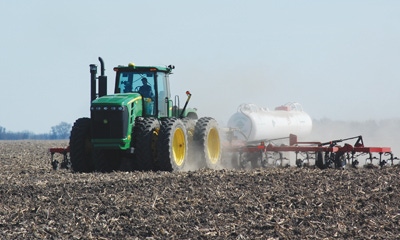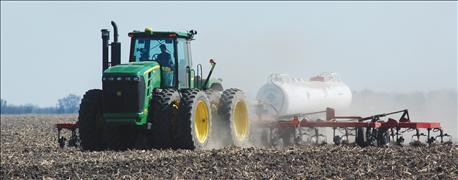
Why would someone still apply nitrogen this fall, six to eight months before the corn crop will use it?
“Typically, there can be economic advantages to fall application if you can reduce N loss,” says Dan Ritter. He is an agronomist for Brodbeck Seeds, Rensselaer, and an Indiana Certified Crop Adviser. “A fall application can reduce your spring workload and widen your nitrogen application window.”
However, Ritter realizes there can be potentially more loss of N, leading to environmental concerns, unless proper precautions are taken.

APPLY N IN FALL OR WAIT? Less N is applied in the fall now than was at one time in Indiana. Both the environment and economics impact the decision of when to apply nitrogen.
“I wouldn’t apply fall anhydrous ammonia without a nitrification inhibitor,” he says. “We can minimize environmental impact by using an N inhibitor and applying after soil temperatures are below 50 degrees F. At 50 degrees, biological activity slows and reduces the nitrification process by bacteria.”
Go with inhibitor
Betsy Bower is not a fan of fall N applications in all parts of Indiana. She is an agronomist with Ceres Solutions, working mostly with farmers in west-central Indiana. “I just think it’s too risky, not knowing what Mother Nature is going to provide us regarding soil temperatures in late fall and early spring,” she says. “We also don’t know about rainfall. It can leach or denitrify N depending on soil type.”
If you are going to fall apply, Bower, like Ritter, strongly recommends an N inhibitor.
Some soil types are better for fall N applications than others, she notes. Candidates would include well-drained loams, silt loams or clay loams. “I’m most concerned with sandy soil types due to the potential to leach, and with heavy, wet soil types due to the possible loss of N due to denitrification in wet soils,” she says.
Brian Shrader, accounts manager for DuPont Pioneer in Marion and also a CCA, agrees that if you are going to apply commercial fall N, it should be anhydrous ammonia with a nitrification inhibitor. He believes it might fit better in some parts of the state than others.
“Areas of the state that have poor soil drainage, high water-table levels, are close to open water bodies and other similar issues may not be the most appropriate areas for fall N applications,” Shrader says. But he’s not finished. “To suggest that this is no longer a viable option simply wouldn’t be correct for a number of Indiana growers."
Farmers find solutions
Bower cites an example from her area that she finds appropriate. “I’ve heard of applying a low rate of N in the fall, say 100 pounds per acre or so,” she says. “There is still potential to lose N in late fall or early spring, but the loss would not be as much as with a full rate of N.
"The low-rate, fall-applied N improves speed of planting in the spring," she adds. That's due to time spent applying N ahead of planting. The people Bower knows who do this come back with an early sidedress application to apply the balance of N.
Even in this case, she hopes farmers would monitor environmental conditions after application and be ready to apply additional N to the crop next summer. Tissue tests in-season or a pre-sidedress N test before sidedressing may help zero in on rates, she concludes.
About the Author(s)
You May Also Like




